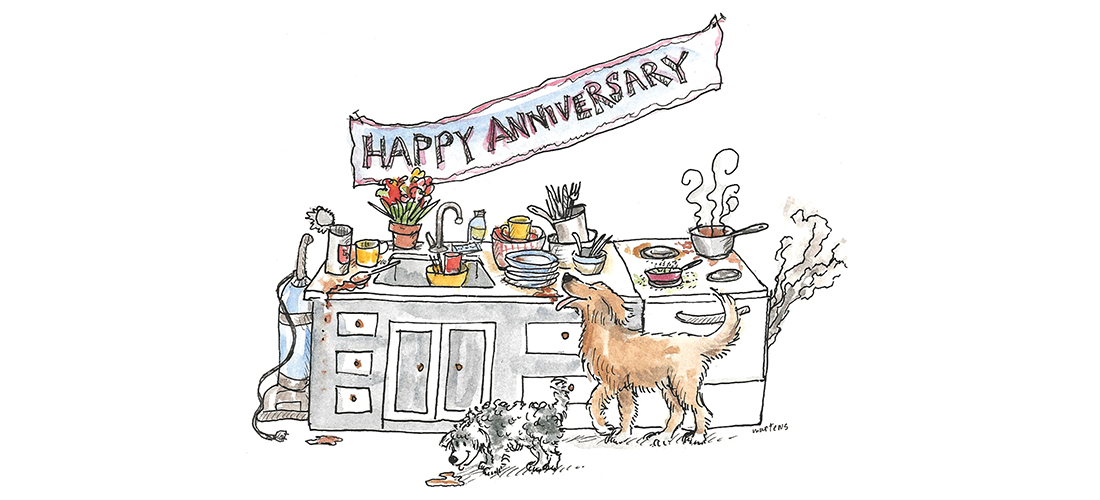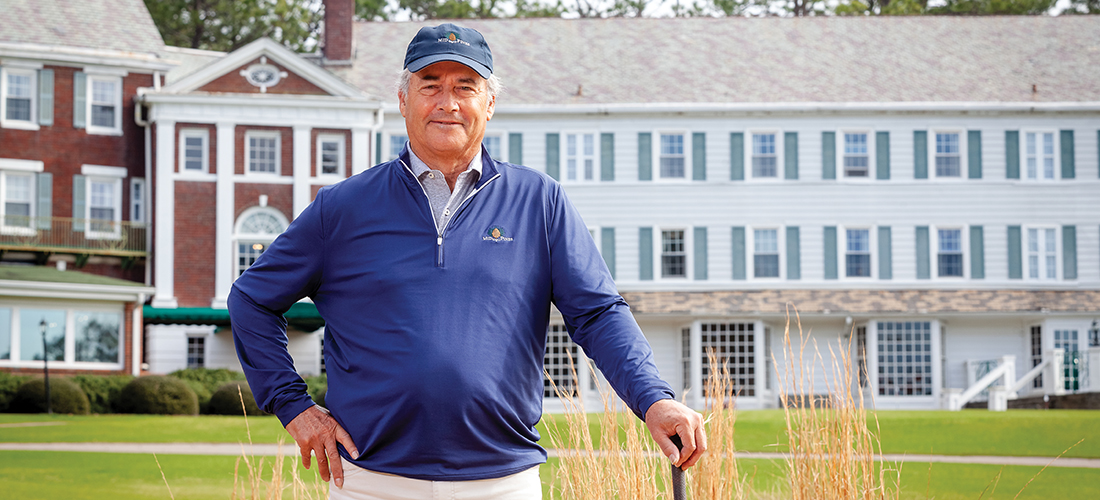Keeping Pinehurst forever in bloom
By Claudia Watson • Photographs by John Koob Gessner
Chris Jones has the soul of a gardener. As assistant superintendent of the grounds department at Pinehurst Resort, he eagerly awaits the Eastertime explosion of colorful tulips extending from the Midland Road roundabout to The Carolina Hotel.
“It’s short-lived but quite beautiful, and I always stop to appreciate the moment,” he says of the over 12,000 bulbs his crew planted last fall. “It brings a lot of smiles to our community.”
The annual tulip bloom is a seminal moment for a resort that takes pride in extending the spirit of Pinehurst’s character and charm, showcasing its beauty beyond golf. For 17 years, the affable Jones has been the hands-on and boots-on-the-ground kind of guy who, like any gardener, is always looking at the land, no matter how familiar, for new possibilities.
He was just 16 when he took his first job in a greenhouse in his hometown, Rocky Mount, North Carolina. Though he didn’t grow up living on a farm, he often visited relatives who did, in an extended family that had farmed vegetables, row crops and tobacco for generations. His mom, who loved to garden, had vegetable and flower gardens.
“She let me experiment in the garden as a kid. We’d work in the flowerbeds tending her favorite bearded irises, and other days we’d pick beans and corn on my aunt’s farm,” he recalls. “My fascination with growing things was always there for me — it’s something of an inheritance from my family.”
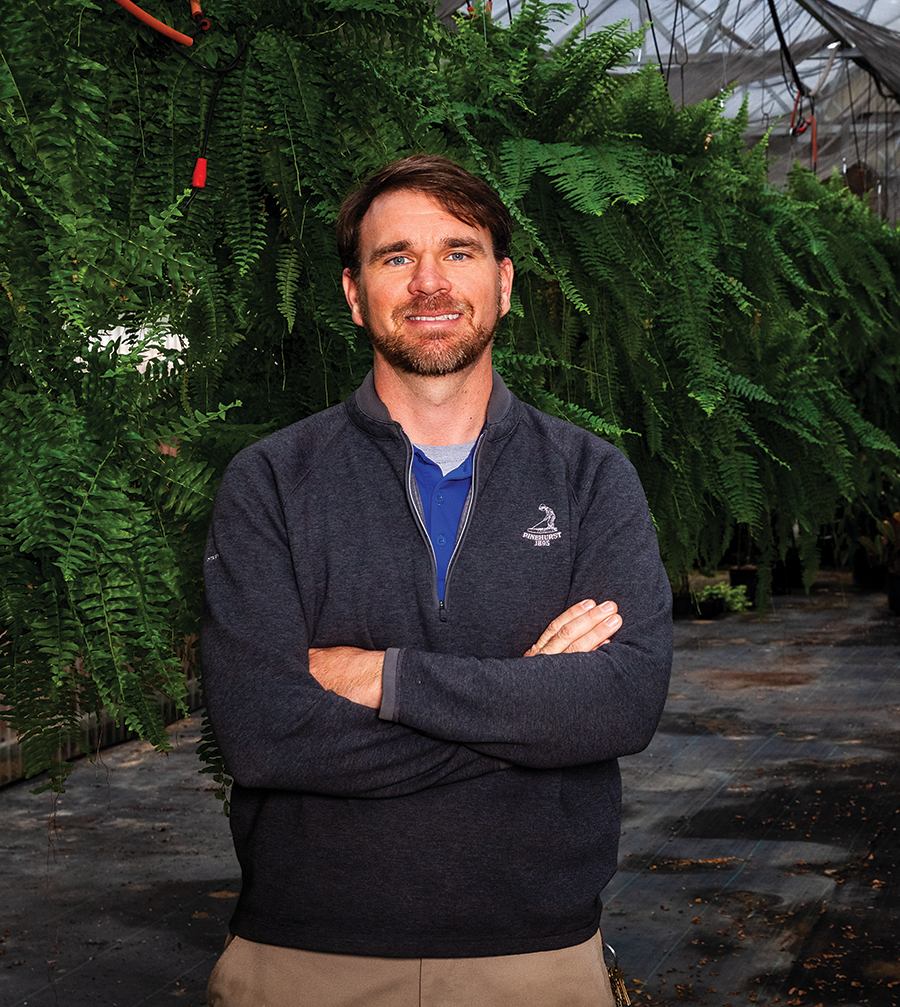
With an avid interest in plant science, he jumped at the chance to take specialized horticulture courses in high school and later received a landscape gardening degree from Sandhills Community College.
After college and an 18-month internship at Homewood Nursery in Raleigh, he found his way back to the Sandhills. When Pinehurst Resort hired him and told him they had a greenhouse, he knew he had found the answer to his career dreams. Encouraged by the department’s manager, Chris Burrows, Jones spends his time directing crews, working with suppliers, designing the landscape, and ordering the plants and materials needed to keep the resort’s grounds in top shape and beautiful.
A team of 10 full-time employees, augmented by a few temporary summertime workers, maintains acres of flowerbeds, shrubs and turfgrass along Carolina Vista to The Carolina Hotel, and all of the hotel and spa grounds. The Holly Inn, Manor Inn, Pinehurst Brewery, as well as the Member’s Club, pool and tennis complexes, and soon, the renovated marina complex are also in their charge.
Two additional employees handle duties in the nearly 20-year-old greenhouse nurturing the crop held there and often transferring numerous towering ficus trees and areca palms to meeting spaces at the hotels. A massive potted, 25-year-old sago palm, dubbed the “granddaddy” of the greenhouse, is retired and quietly watches the activity with nowhere to go.
Springtime means moving 60 Boston ferns from the greenhouse’s cozy climate to the wide porches of The Carolina Hotel and designing 125 pots with panache to enliven the resort’s grounds. And, there is no reprieve during the holidays when they tend to 500-600 poinsettias on display in the hotel.

From late winter to early May, the resort’s 17,000-square-foot greenhouse, tucked behind the stables at the Pinehurst track facility, becomes the hub for Jones’ operations. With nearly 2 acres of beds planted each spring and fall, he has the effort down to pure science and timing.
Work on this year’s spring beds began last fall, when he tested the soil, selected plants, calculated quantities and placed orders. In the early spring, the grounds crew tills organic matter from Brooks Contractor into the soil, readying the beds for planting.
The suppliers’ trucks begin arriving in late February to off-load thousands of seedling plugs grown in cell trays. In a typical year, Jones will order over 100,000 plant plugs.
“This is when things start happening in the greenhouse,” he says with a wink. “It’s crazy fun and often challenging if the weather isn’t cooperating.”
The grounds team gathers and begins the labor-intensive process of pulling the delicate seedling plugs from their cells and transplanting them into the larger Ellepots. The advanced organic paper pots are made in the U.S. on a machine from Denmark and decompose in three to five months.
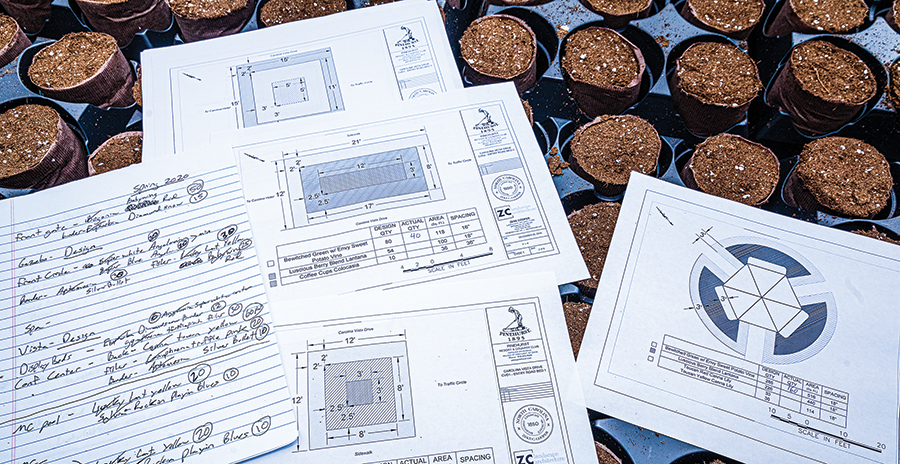
The spring season order includes many different kinds of plants with a wide range of growing requirements, from tender annuals and perennials to succulents and just about everything in between. Under Jones’ management, the plugs grow large enough to transplant into the ground within five weeks.
“Our greenhouse is full and beautiful for six weeks,” he says, emphasizing it’s also one of the busiest times of the year.
“In mid-April we start planting, and it takes three to four weeks. The entire crew works quickly pulling out old plant material, tilling the soil, and planting all of the new beds on the property.”
Jones designs both large and small landscapes throughout the resort. He knows that most Pinehurst visitors are there to play golf and not to appreciate it as a garden space, “but gardens are important to our Southern charm and history, so we want to make them enjoyable and beautiful.”
And they don’t happen by accident. Jones says the first tip is to follow the golden rule of gardening: The better the soil, the better the garden.
To build good soil, a soil test is essential. “A soil test gives the baseline of your flowerbeds, vegetable gardens, and turf,” he says. “If your plants are looking bad or dying, it could be because they’ve used up most of the available nutrients from the soil, or possibly the pH is off from the optimal range of what you are trying to grow.”

Jones recommends consulting the North Carolina Cooperative Extension office in Carthage. Soil test kits and analysis are free or low-cost, and the analysis results arrive by mail or email in a few weeks. The Cooperative Extension’s master gardeners are available to answer questions about soil tests or gardening concerns. He also suggests that homeowners review the plant’s cultural requirements — essential information about the soil, sunshine, water and the climate needs. It can be found on the plant’s tag (though that information is generic and, hence, sometimes wrong) or by researching the plants.
Jones has had his share of vexing challenges, from frostbitten and dead plants to the deer that recently discovered the buffet of tulips and pansies along Carolina Vista. He regularly sprays Liquid Fence to keep them away.
Experience being the teacher, Jones uses only time-tested, durable plants that resist disease, pests, and tolerate the Sandhills growing conditions.
He calls heat-loving lantana a workhorse. “It offers options for color and size, and it doesn’t mind sandy soil or require lots of irrigation, plus it’s a butterfly magnet.”
Last year, at the Holly Inn, he used a combination of New Gold lantana, a low-growing, dense variety, and mixed in a spikey, deep blue salvia, Rockin’ Playin’ the Blues, Salvia longispicata x farinacea, from Proven Winners.
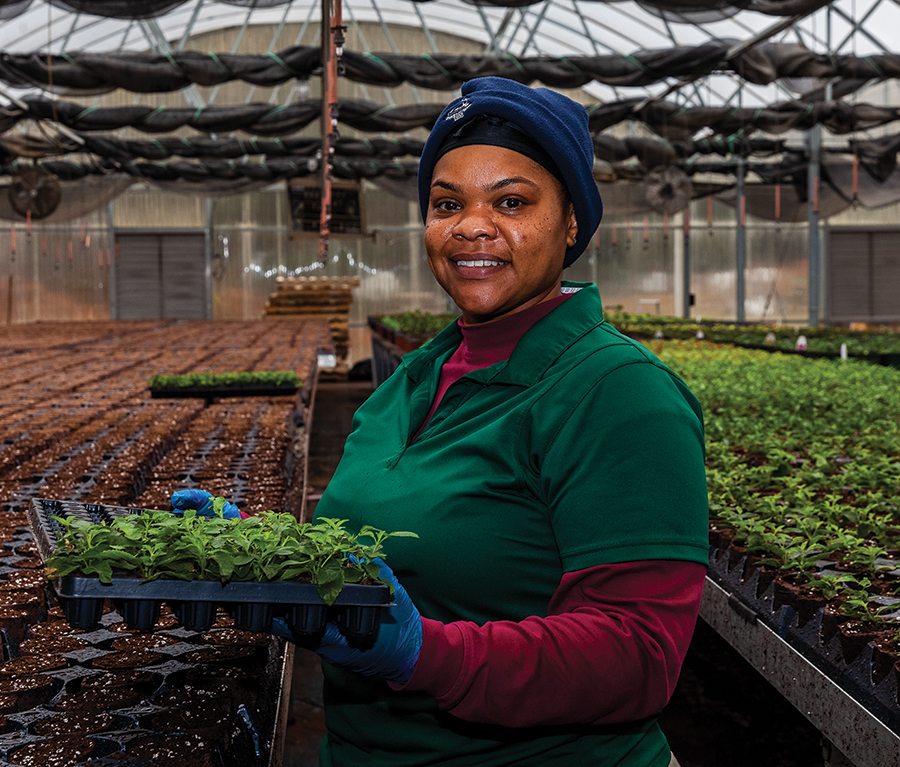
“It was outstanding, full, and very natural,” he says. “It looked sensational into fall and generated lots of compliments.”
Another of his favorites is Lemon Coral, sedum mexicanum, a beautifully textured succulent with chartreuse foliage that edged the beds along Carolina Vista last spring.
“It held up and grew back despite being trampled during the U.S. Kids Golf Parade of Nations,” he laughs. “Now, that’s a great plant!”
A homeowner can spend a lot on their landscape only to see plants and shrubs fail because they are not well-suited to our climate, soil, or they have low disease resistance. Jones recalls the candy-colored beds of impatiens planted each spring along Carolina Vista and throughout the community.
“They were gorgeous, but an invasion of impatiens downy mildew (a fungus-like water mold that is wind-borne) ended their reign. When that happened, suppliers and consumers got turned off. We looked for newer varieties with greater disease resistance,” he recalls.
“The same thing happened with begonias. Some of those have terrible disease resistance, but many of the newer varieties perform beautifully, and we’re using them in beds.”
Shrubs can also succumb to disease and old age. Recently, Jones needed to replace some hollies and laurels in the resort’s landscape and introduced distylium, a broadleaf evergreen that provides the backdrop to a more modern view.
“I wanted something that had a lovely, full look and didn’t need excessive pruning,” he says, echoing homeowners weary of their shrubs pruned to look like “meatballs.”
“We’re using it as a mid-range low shrub for the foundation, and it’s adapted well and is now the go-to replacement as we renovate.”
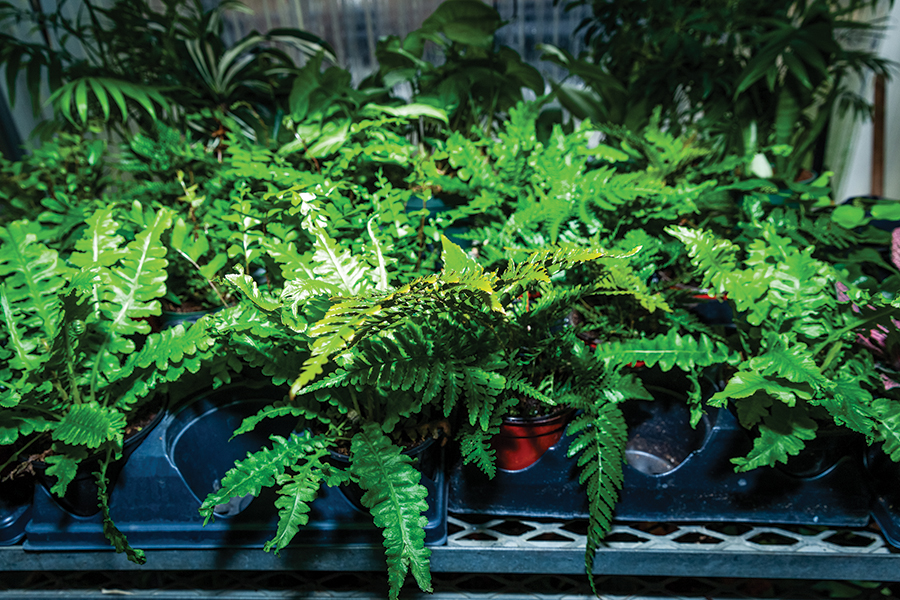

Jones, a flower lover at heart, also cautions homeowners who are tempted by the big, showy blooms in garden centers.
“Look for a plant that has a bud that’s still closed,” he says. “If you buy the one that is in mid- or full-bloom, you’ve already missed the first couple weeks of their beauty.”
He uses angelonia, a late-summer blooming annual, for continuous color in combination pots or the garden.
“We plant it as a mature plug with glossy green foliage. But when the summer heat comes on, it gets taller and fuller with upright spikes of color — so it’s working for the season, not just a few weeks.”
And, like home gardeners, he understands the temptation to tear out plants that didn’t work or are deteriorating and plant anew.
“I see areas that we want to update with something more than azaleas, camellias and hollies,” he says. “As we introduce new plants, some perennials and shrubs, the landscape is becoming more visually exciting.”
A few years ago, an area across from the member’s pool and tennis facilities needed renovating. Shaded by towering longleaf pines that notoriously suck up soil nutrients and moisture, the understory beds were robbed of life.
Now renewed, the space features lovely miscanthus sinensis Adagio and panicum virgatum Thundercloud grasses and colocasia esculenta Coffee Cups, a graceful tropical plant that grows to 6-feet tall. The black stems support cup-like foliage, which collects rainwater, and when full, the stem bends to pour the water.
In 2017, after the renovations of the hotel’s east wing, his interest was sparked when asked to redesign the large, overgrown area that runs hundreds of feet in length from the east wing to the spa.
Jones introduced many plants not used anywhere else in the resort, including beds of hydrangea paniculata Tardiva, a cold-hardy, late-blooming variety of hydrangea. Its showy white flower heads turn purplish-pink in the late fall as the foliage changes from yellow to mahogany.
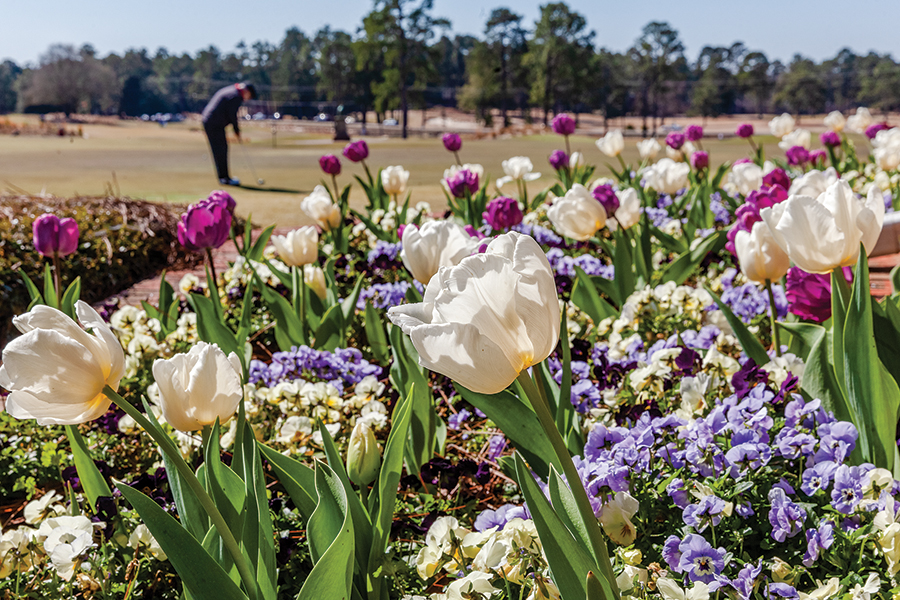
“It’s a fabulous space for weddings and small outdoor gatherings,” he says. “And it takes your breath away when it’s in bloom during the late summer.” The project was a source of well-deserved praise and a sense of pride for him.
“I designed this on paper,” he says. “I researched plants, studied their cultural requirements, made the soil amendments, and designed and installed a new irrigation system. I was on hand for the entire process. And I loved it. When I walk by it now, I think, wow, I created this.”
Jones is among only 11 commercial landscape professionals in the U.S. who carry the credential “Proven Winners Certified Landscape Professional.” And he is a founding member of that company’s advisory committee. The award designates that he has professional expertise in the use of their branded plants and expertly showcases them in landscape designs.
His professional growth as a respected landscape professional doesn’t outweigh his centering passion. “My favorite place is still the greenhouse. It’s enjoyable and always uplifting to be able to create beautiful things,” he says. “At the end of a week after planting, fertilizing, and watering all those seedling plugs, there’s nothing better than opening that door on Monday morning and seeing a bunch of buds coming on.” PS
Claudia Watson is a frequent contributor to PineStraw and The Pilot and finds the joy in each day, often in a garden.

